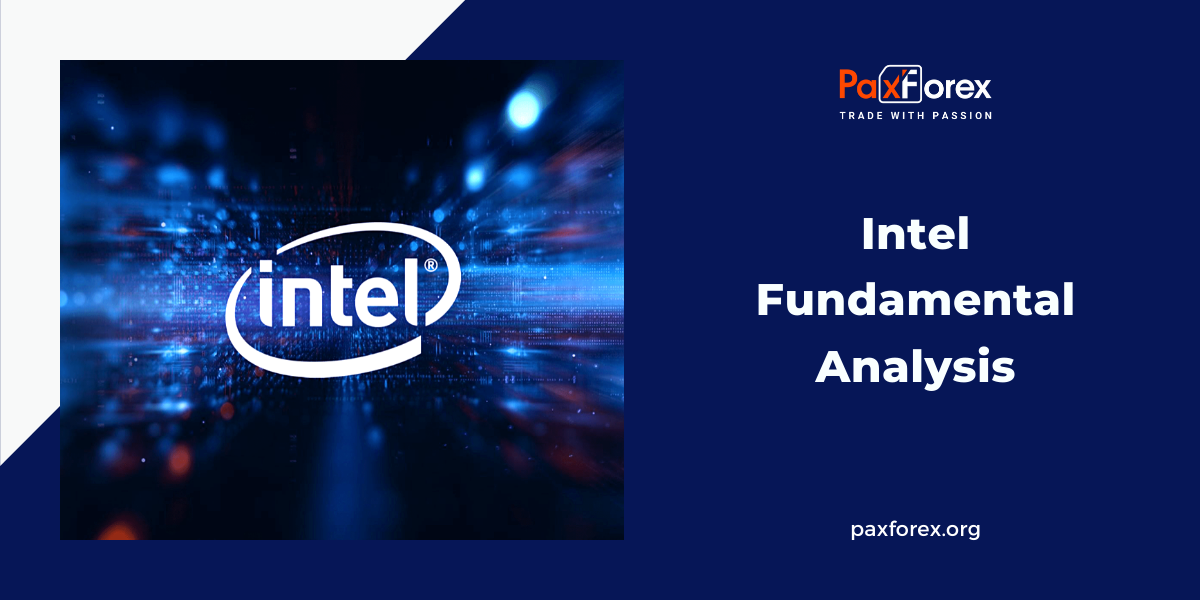
Source: PaxForex Premium Analytics Portal, Fundamental Insight
The beginning of a new year is a good time to look for lagging stocks that could be on the cusp of a rise. One of the cheap technology stocks that stand out is Intel.
Intel has lost significant market share to competitors in recent years, but it still holds the lion's share of chip sales, and CEO Pat Gelsinger has an unambiguous plan for regaining the lead. Here are some reasons why Intel stock is a good buy.
- Don't underrate the market share leader
Advanced Micro Devices beat Intel by outsourcing chip production to Taiwan Semiconductor Manufacturing, which helped AMD accelerate innovation. Intel's share of the processor market has fallen from more than 80% to 60% in the past five years, according to PassMark.
But that means Intel still controls the $425 billion semiconductor industry. It's a trusted brand with a long history and superior manufacturing scale that can't be discounted. A bright spot last year was the strong demand for Tiger Lake processors for laptops, which shipped 70 million units. Tiger Lake is Intel's fastest-growing notebook processor in the company's history. Indeed, Intel is still going strong and capable of much higher performance.
- Steady performance with room for progress
Intel reported strong demand in all segments in Q3, posting record results in data centers, autonomous driving solutions (Mobileye), and the Internet of Things. Revenues were up 5% year over year, and earnings per share were up 64%.
During the third-quarter earnings report, CEO Pat Gelsinger said: "Demand remains strong in all of our segments, and I continue to believe that we are just beginning a cycle of sustained growth that we are well-positioned to capture."
- Growth catalysts
In December, Intel announced plans to float Mobileye, which could lead to a $50 billion increase in the company's value. Intel will retain a controlling stake in its driverless systems solutions division. This is just the beginning of upcoming strategic moves that could lead to a rise in the company's stock.
To regain industry leadership by 2025, Intel is altering the way it makes chips. Intel is moving slower than AMD because it does everything, including the design and manufacture of its products, in-house.
Going forward, Intel plans to get some components from TSMC, which should speed up chip development. Intel is spending $20 billion to build new chip plants in Arizona. It also intends to set up its own foundry service to compete with TSMC in producing chips for other companies.
In addition, the company's management has outlined a clear plan for chip manufacturing technology development over the next four years. The current production schedule calls for a transition from 10-nanometer (Intel 7) process nodes to 7-nanometer (Intel 4) by the end of 2022. Intel 20A, formerly known as 5-nanometer, will go into production by the end of 2024.
These announcements have not gone overlooked by analysts. If Intel acts on these timelines, the market will likely reward the stock with a higher valuation.
- Return on equity improvement
Intel has plenty of cash to reinvest in new technologies. In the past four quarters, the company has generated $17 billion in free cash flow, and that's after spending $15 billion on research and development.
Over the past five years, free cash flow has increased by a total of 51%, and return on invested capital, a key measure of profitability, has also risen from 12% to 18%.
- Attractive value and a dividend yield
Intel's constant free cash flow provides a growing dividend for shareholders. Over the past five years, the dividend per share has grown 32% and now stands at $0.3475 per share. This brings the dividend yield to 2.6%, more than double that of the S&P 500 Index. In addition, Intel pays only 32% of its free cash flow in dividends, giving ample room for further increases.
What's more, the market doesn't give Intel's growth plans the credit they deserve. The company's stock is trading at just 10 times management's adjusted earnings forecast for 2021.
As Intel accelerates innovation and gets back on track, there is a good chance it will outperform the broader market from these levels.
As long as the price is above 51.70, follow the recommendations below:
- Time frame: D1
- Recommendation: long position
- Entry point: 55.20
- Take Profit 1: 57.50
- Take Profit 2: 58.80
Alternative scenario:
If the level of 51.70 is broken-down, follow the recommendations below:
- Time frame: D1
- Recommendation: short position
- Entry point: 51.70
- Take Profit 1: 49.40
- Take Profit 2: 48.00













